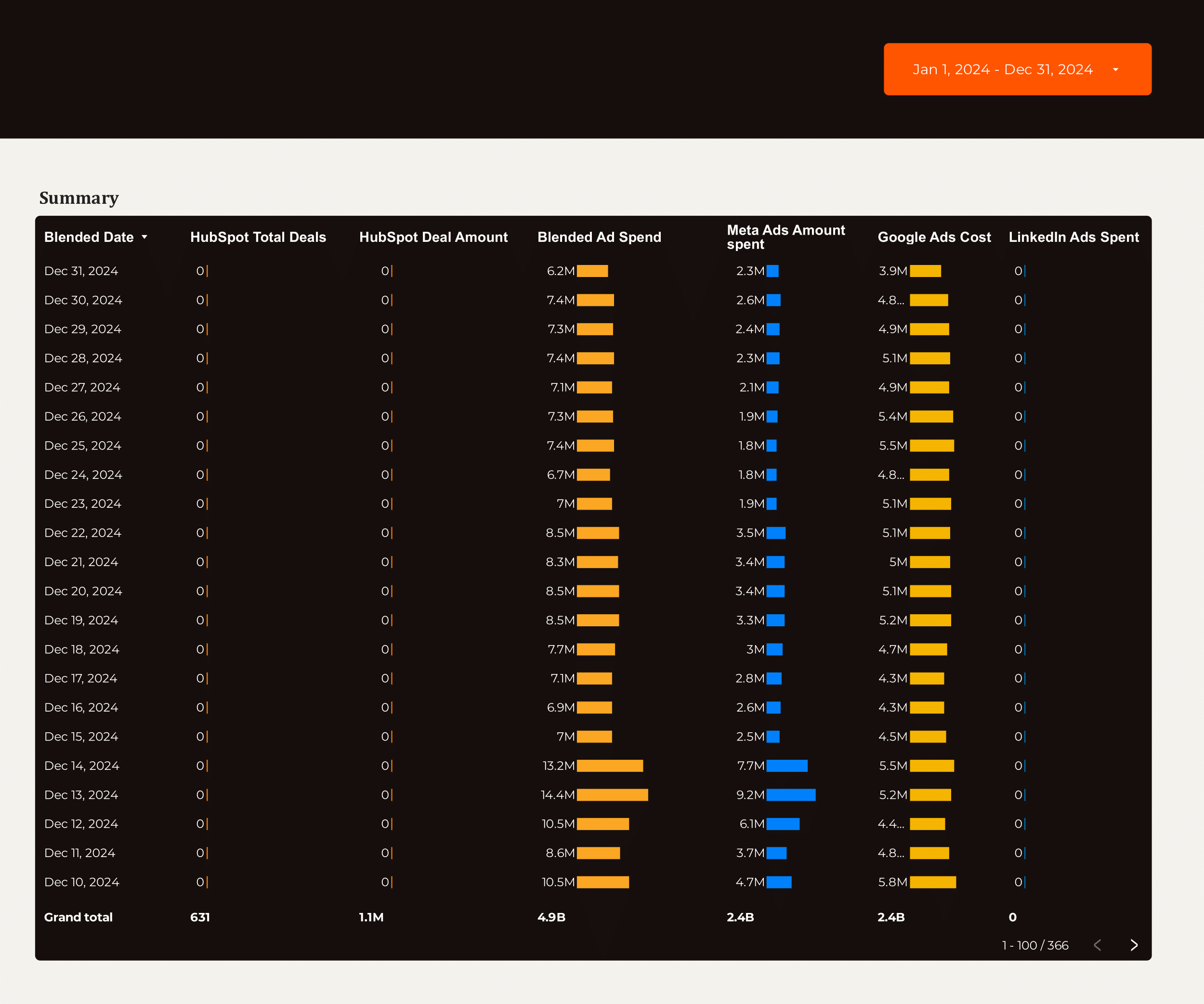
Lead generation Dashboard template
The Lead Generation Dashboard Template is designed for B2B marketers and sales teams to streamline their lead management process. This template integrates with popular platforms such as Google Ads, LinkedIn Ads, Facebook Ads, and HubSpot, providing a centralized view of your lead generation efforts.
Utilize data from Google Analytics 4 to track and analyze the performance of your campaigns. The dashboard offers insights into:
- Lead Sources: Identify which channels are driving the most leads.
- Conversion Rates: Monitor the effectiveness of your PPC campaigns.
- CRM Integration: Seamlessly connect with HubSpot to manage and nurture leads.
This template is essential for businesses looking to optimize their B2B lead generation strategy by leveraging data from multiple advertising and analytics platforms.
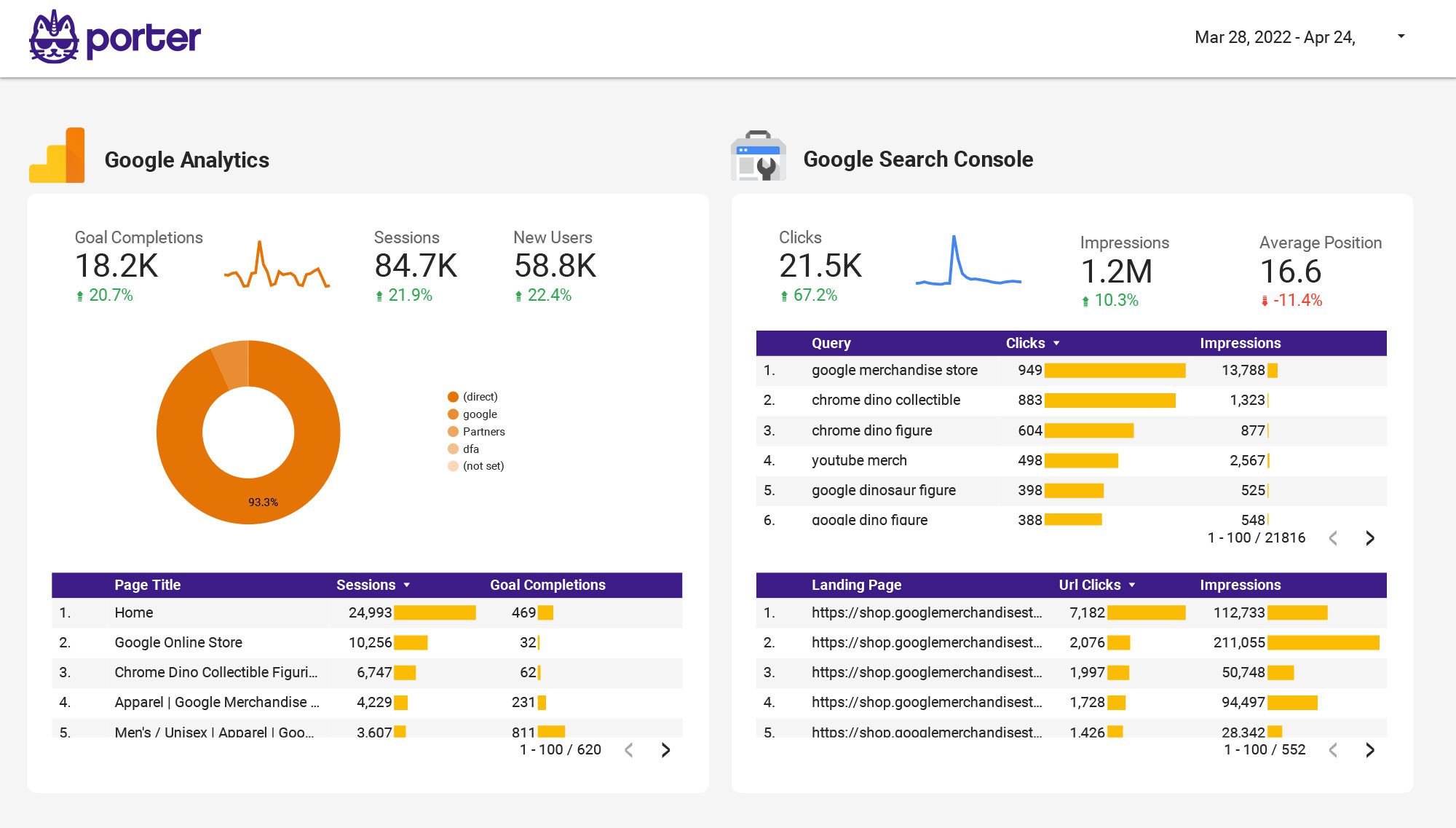
Multi-channel Marketing performance Dashboard template
The Multi-channel Marketing Performance Dashboard template provides a centralized view of your marketing efforts across various platforms. This dashboard integrates data from Google Analytics 4, Instagram Insights, Google Ads, YouTube, Facebook Insights, Facebook Ads, LinkedIn Ads, TikTok Ads, and Twitter Ads.
With this template, you can:
- Track SEO performance and analyze website traffic using Google Analytics 4.
- Monitor social media engagement and audience growth through Instagram and Facebook Insights.
- Evaluate advertising campaigns across Google Ads, Facebook Ads, LinkedIn Ads, TikTok Ads, and Twitter Ads.
- Analyze video content performance on YouTube.
This dashboard template is designed to provide actionable insights by consolidating data from multiple channels, allowing for a streamlined analysis of marketing strategies and outcomes.
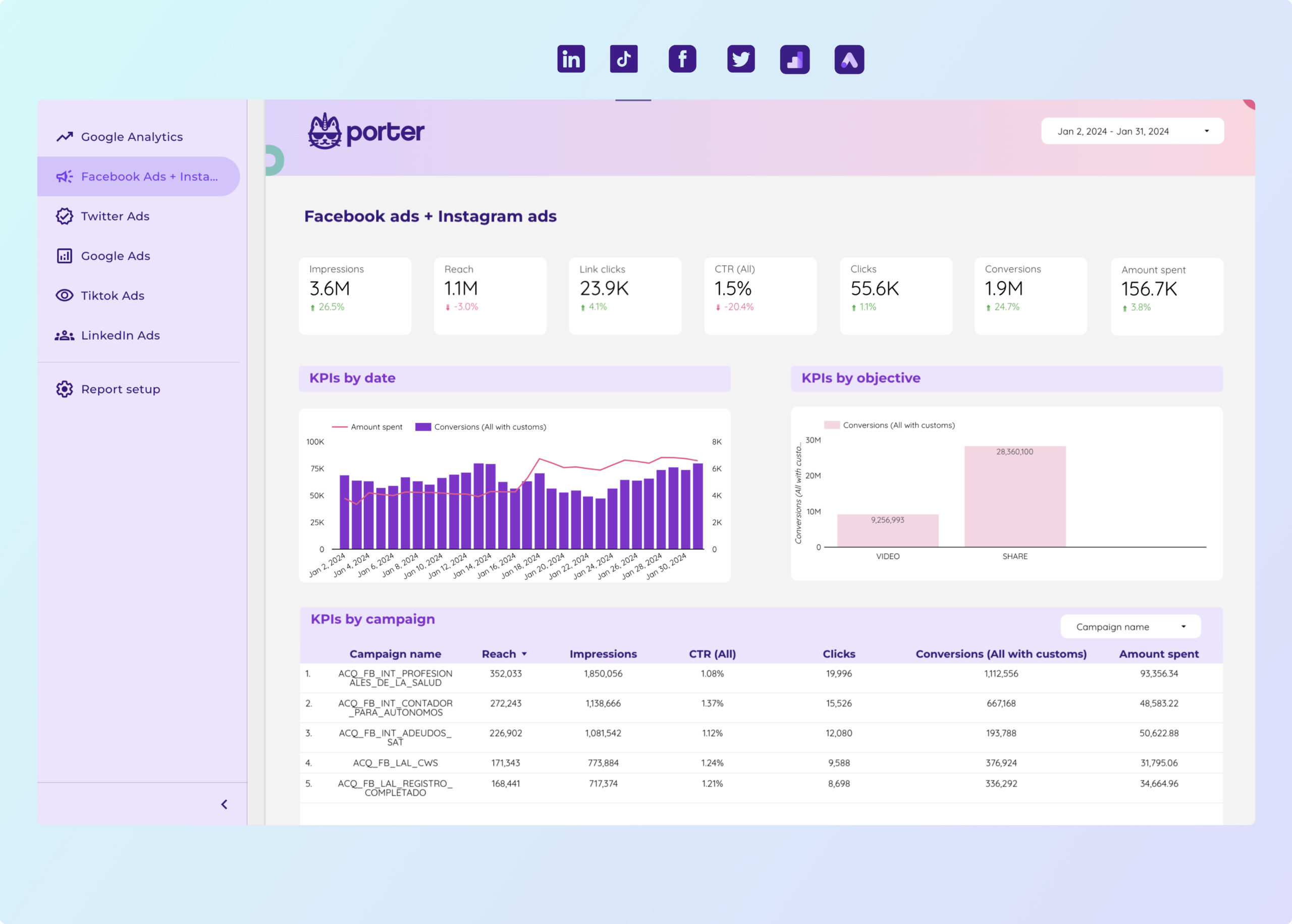
Paid media Dashboard template
This Paid Media Dashboard Template is designed for marketers managing campaigns across multiple platforms. It integrates data from PPC channels such as Google Ads, Facebook Ads, LinkedIn Ads, TikTok Ads, and Twitter Ads.
Utilize this dashboard to track and analyze performance metrics from Google Analytics 4 and Base. The template provides a centralized view of your advertising efforts, allowing for data-driven decision-making.
- Google Ads: Monitor impressions, clicks, and conversion rates.
- Facebook Ads: Analyze audience engagement and ad spend.
- LinkedIn Ads: Evaluate lead generation and campaign reach.
- TikTok Ads: Track video views and user interactions.
- Twitter Ads: Assess tweet engagement and follower growth.
This template is ideal for marketers seeking to consolidate their advertising data into a single, actionable view.
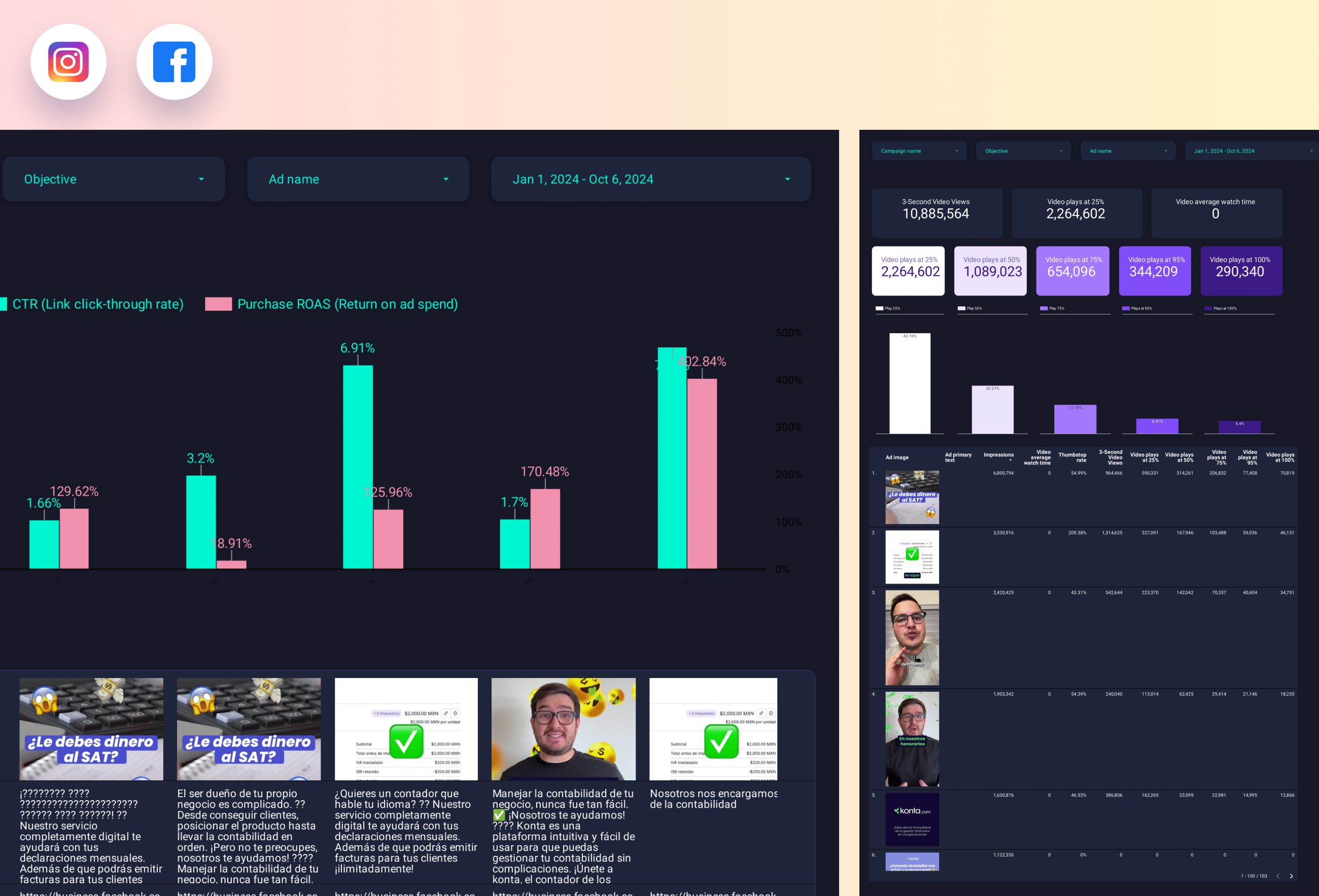
Paid media Creative performance Dashboard template
The Paid Media Creative Performance Dashboard template is designed for marketers managing campaigns across multiple platforms such as PPC, TikTok Ads, Google Ads, Facebook Ads, LinkedIn Ads, and Twitter Ads.
This dashboard provides a centralized view of your advertising efforts, allowing you to track and analyze performance metrics in real-time. It supports:
- Impressions and Clicks tracking for visibility and engagement analysis.
- Cost-per-click (CPC) and Cost-per-acquisition (CPA) metrics for budget management.
- Conversion rates to measure the effectiveness of your ad creatives.
- Platform-specific insights for TikTok, Google, Facebook, LinkedIn, and Twitter.
Utilize this dashboard to streamline your reporting process and make data-driven decisions for optimizing your ad campaigns.
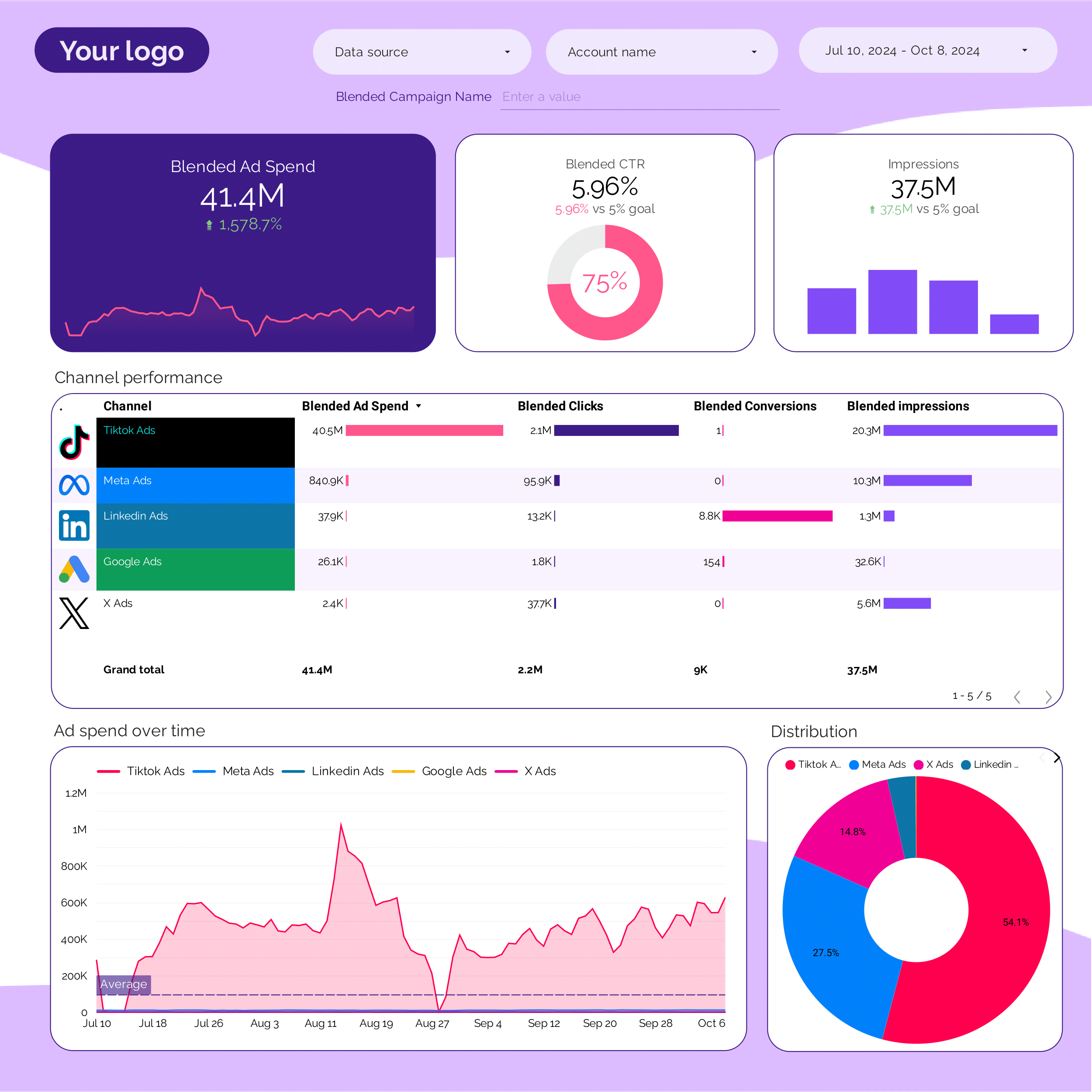
PPC Dashboard template
The PPC Dashboard Template is designed for managing and analyzing advertising campaigns across multiple platforms. This template supports:
- Google Ads
- Facebook Ads
- LinkedIn Ads
- TikTok Ads
- Twitter Ads
Utilize this dashboard to track performance metrics such as click-through rates (CTR), cost per click (CPC), and conversion rates. The template provides a centralized view of your advertising data, allowing for streamlined reporting and analysis.
Features include:
- Real-time data integration from all supported platforms
- Customizable widgets for specific campaign insights
- Automated reporting for daily, weekly, and monthly performance
This template is ideal for marketers looking to optimize their PPC strategies across various social media and search engine platforms.

ROAS Dashboard template
The ROAS Dashboard Template is designed for marketers managing PPC campaigns across multiple platforms. This template provides a centralized view of your Return on Ad Spend (ROAS) metrics, allowing for data-driven decision-making.
Track and analyze performance from various advertising channels, including:
- Google Ads
- LinkedIn Ads
- Facebook Ads
- TikTok Ads
- Twitter Ads
Utilize this dashboard to monitor campaign performance, compare ROAS across platforms, and optimize your advertising strategy. The template integrates seamlessly with data sources, providing real-time insights into your advertising spend and revenue generation.
PPC budget tracking and pacing Dashboard template
The PPC Budget Tracking and Pacing Dashboard template is designed for managing and monitoring advertising spend across multiple platforms, including Facebook Ads, Google Ads, LinkedIn Ads, TikTok Ads, and Twitter Ads.
This dashboard provides a centralized view of your advertising budget and spend, allowing for real-time tracking and adjustments. It is structured to support the following functionalities:
- Budget Allocation: Set and adjust budgets for each platform to align with campaign goals.
- Spend Monitoring: Track daily, weekly, and monthly spend to ensure alignment with budgetary constraints.
- Pacing Analysis: Evaluate spend rates to determine if campaigns are on track to utilize the allocated budget effectively.
- Performance Metrics: Integrate key performance indicators (KPIs) to assess the impact of spend on campaign outcomes.
Utilize this dashboard to maintain control over your PPC campaigns, ensuring that your advertising spend is optimized across all platforms.
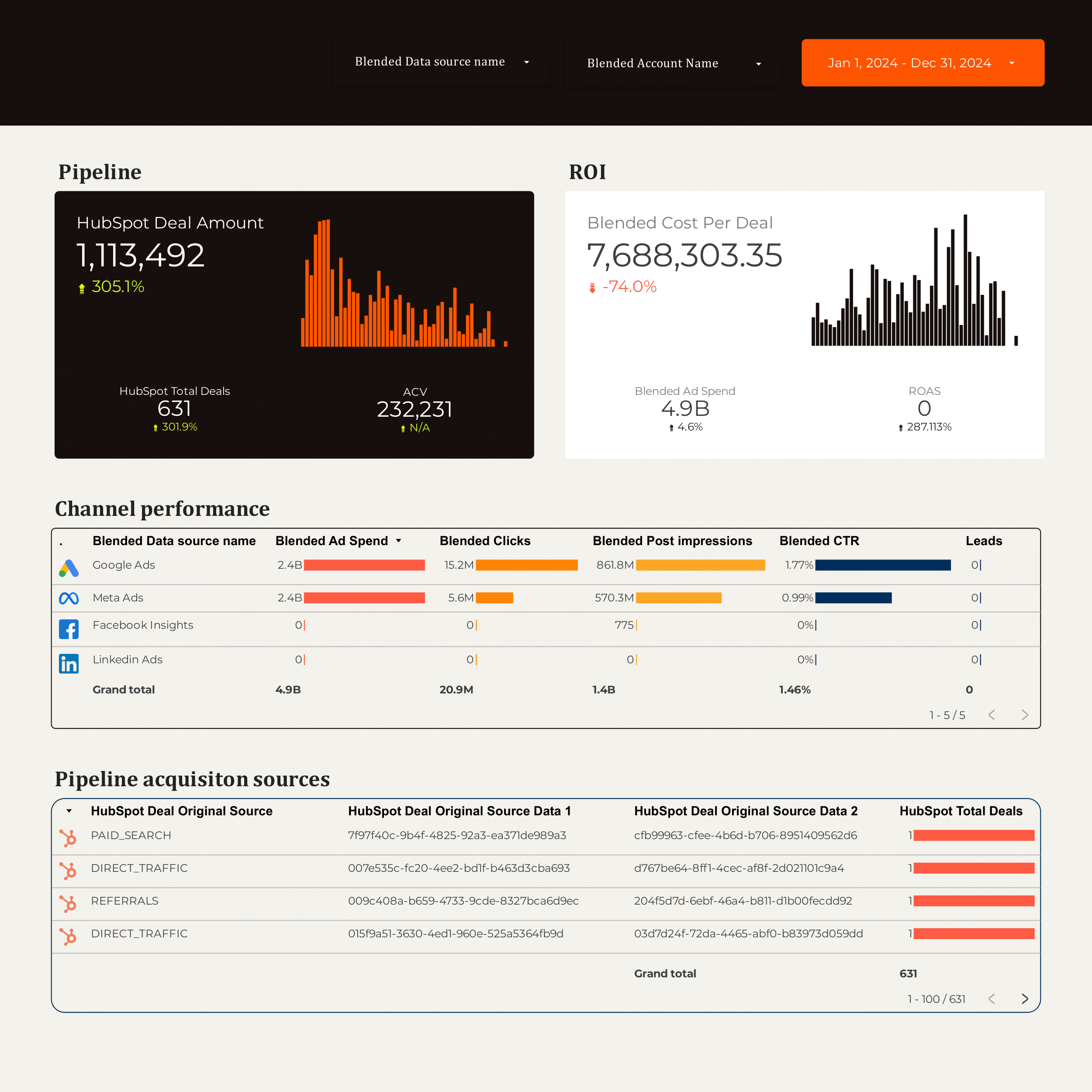
B2B Dashboard template
The B2B Dashboard template integrates with HubSpot, Facebook Ads, Google Ads, LinkedIn Ads, and Google Analytics 4 to provide a centralized view of your marketing and sales data.
Utilize this dashboard to track and analyze:
- CRM Data from HubSpot for lead management and sales performance.
- PPC Campaigns across Facebook, Google, and LinkedIn Ads to monitor ad spend and ROI.
- SEO Metrics to assess organic search performance and traffic sources.
- Website Analytics through Google Analytics 4 for user behavior insights and conversion tracking.
This template is designed for B2B marketers seeking to streamline data from multiple platforms into a single, actionable interface.

PPC Campaign performance Dashboard template
The PPC Campaign Performance Dashboard template provides a centralized view of your advertising efforts across multiple platforms. This dashboard is designed to track and analyze the performance of your campaigns on Facebook Ads, Google Ads, LinkedIn Ads, TikTok Ads, and Twitter Ads.
With this dashboard, you can monitor:
- Impressions and Clicks to understand audience engagement.
- Click-Through Rate (CTR) to measure the effectiveness of your ad creatives.
- Cost Per Click (CPC) and Cost Per Acquisition (CPA) for budget management.
- Conversion Rates to assess the success of your campaigns in achieving desired actions.
- Return on Ad Spend (ROAS) to evaluate the profitability of your advertising investments.
This template allows for a detailed comparison of performance metrics across different platforms, providing insights into which channels are delivering the best results.
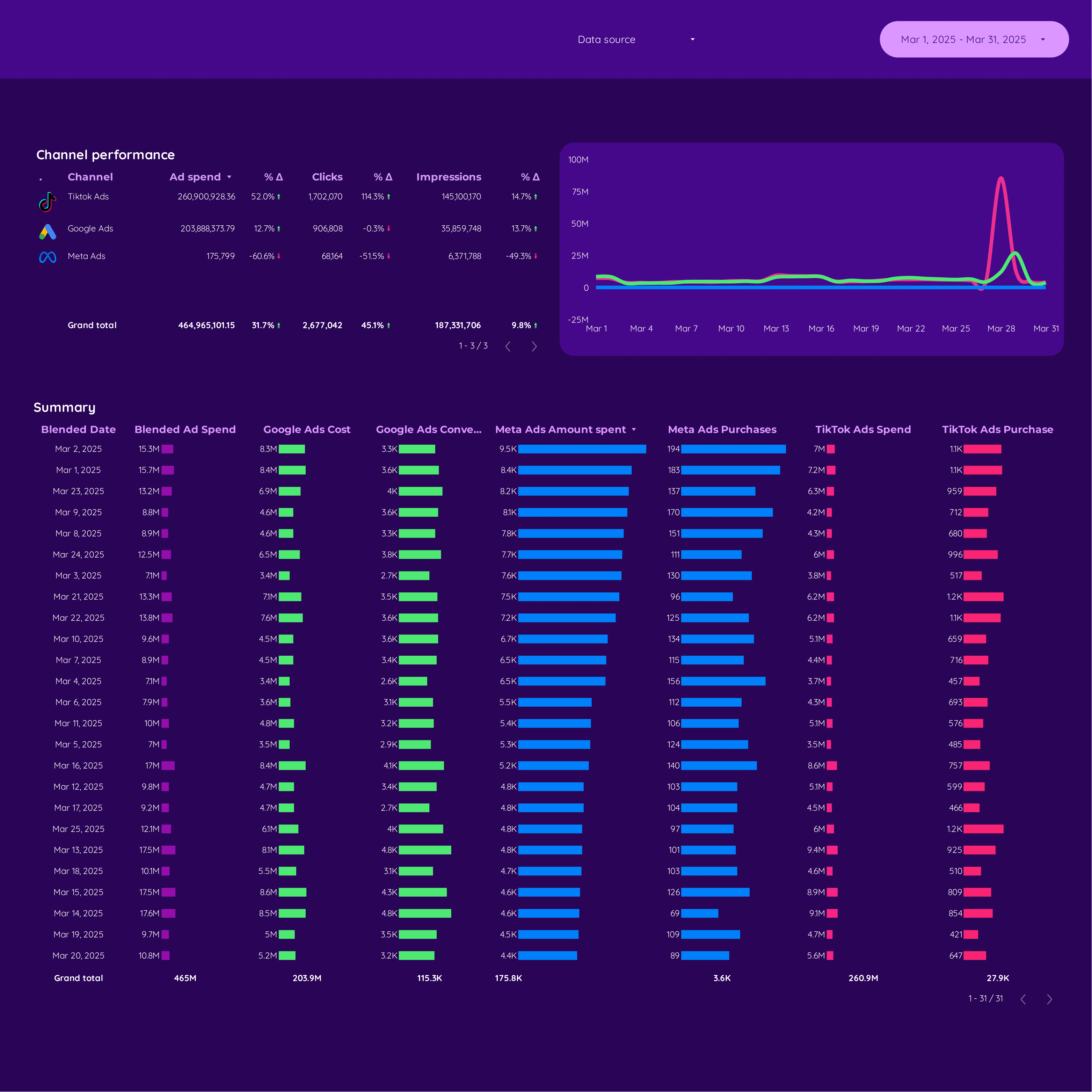
Cross-channel Dashboard template
The Cross-channel Dashboard template is designed for PPC and Marketing professionals in the E-commerce and B2B sectors. This template provides a centralized view of your advertising efforts across multiple platforms.
Track and analyze performance from:
- Facebook Ads
- Google Ads
- LinkedIn Ads
- TikTok Ads
Utilize this dashboard to monitor campaign metrics, compare platform performance, and make data-driven decisions. The template supports integration with various ad platforms, allowing for real-time data synchronization and reporting.
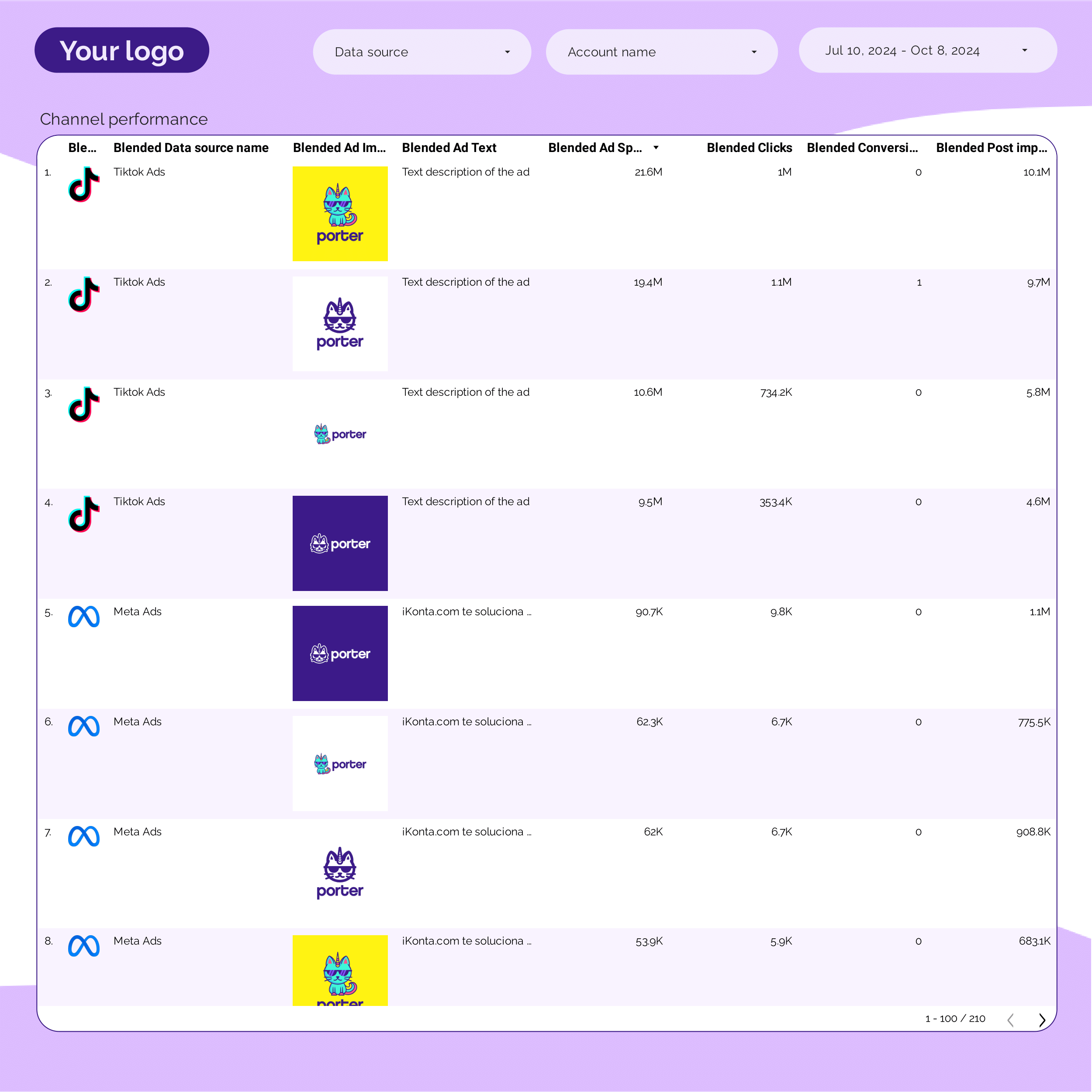
PPC Creative performance Dashboard template
The PPC Creative Performance Dashboard template provides a centralized view of your advertising efforts across multiple platforms, including Facebook Ads, Google Ads, LinkedIn Ads, TikTok Ads, and Twitter Ads.
This dashboard focuses on creative performance metrics to help you analyze and optimize your ad creatives. It includes:
- Impressions: Track the number of times your ads are displayed.
- Clicks: Monitor the number of clicks your ads receive.
- CTR (Click-Through Rate): Calculate the percentage of clicks per impression.
- Conversion Rate: Measure the percentage of clicks that result in a conversion.
- Cost Per Click (CPC): Analyze the average cost incurred for each click.
- Cost Per Conversion: Determine the cost associated with each conversion.
Utilize this dashboard to compare performance across different platforms and identify trends in your ad creatives. This tool is essential for marketers looking to maximize their advertising ROI by focusing on creative elements that drive results.
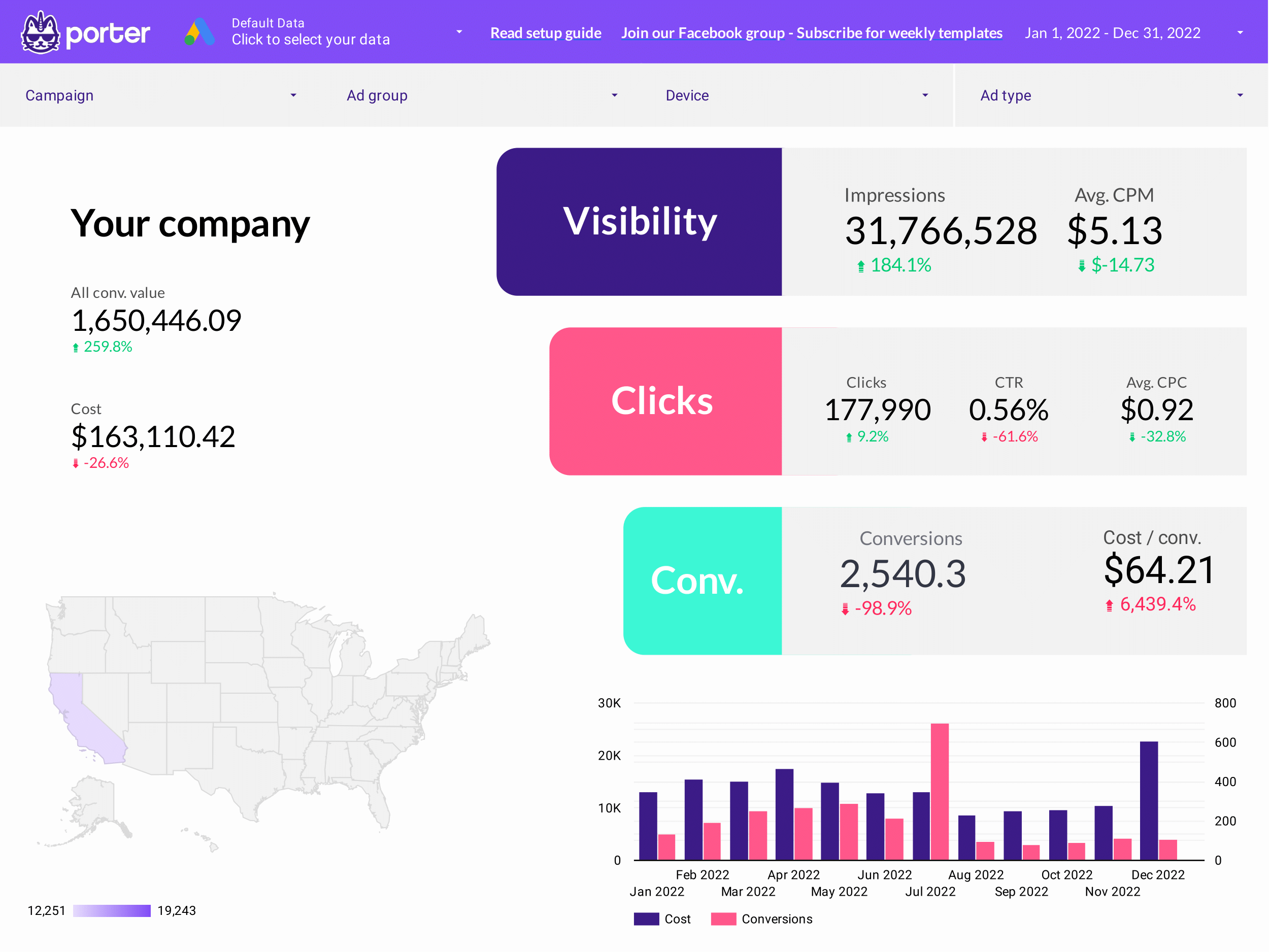
Google Ads Dashboard template
The Google Ads Dashboard Template is designed for PPC professionals seeking to streamline their advertising efforts. This template provides a structured view of your Google Ads data, allowing for quick analysis and decision-making.
Features include:
- Campaign Performance Metrics: Track impressions, clicks, and conversions to assess the effectiveness of your campaigns.
- Cost Analysis: Monitor your ad spend and cost-per-click to manage your budget effectively.
- Conversion Tracking: Evaluate conversion rates and return on ad spend to optimize your strategies.
- Keyword Insights: Analyze keyword performance to refine targeting and improve ad relevance.
This template is an essential tool for managing and optimizing your Google Ads campaigns, providing clear insights into your advertising performance.
